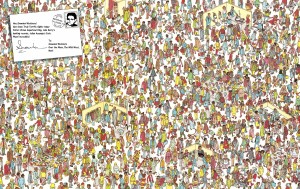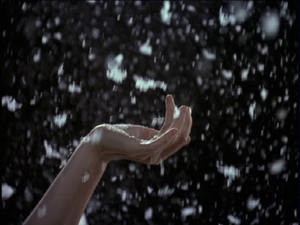As we enter the autumn and most of the northern hemisphere cools and takes on sunset shades, we start to enter a magical time. This is the twilight of the summer season when we can stop pretending to give a shit about whether or not the hedges are trimmed and the weeds are cleared. Instead we now get to watch the world take on a new shade, settle back, and let nature take its course. Before long, some of us will find ourselves watching snow fall through a window of our cozy dens. Not me though, I live in California where it’s still in the mid-90s in October.
But while I contemplate a trip to the cold depths of Siberia to escape this hell, others have far more pleasant plans to make. National Novel Writing Month is almost upon us once more in November, and it’s time for some of us to dust off some old projects or start anew with the power of community behind us. It’s a joyful time, practically the writer’s holiday season, when good will is shared among all and we each find a little bit of comfort from each other. To acknowledge this, years ago I wrote my first real writing advice posts and found that it was actually something I liked to do. In fact, since those first few posts I’ve made it a point to make writing advice a regular part of this blog.
But a friend recently pointed out to me that I only superficially touched on a vital topic when I talked about Mystery writing. I’d covered requiring enough evidence to prove your case and the timing for when you should reveal it all, but I didn’t really touch on how you would reveal it. What if you didn’t want something to feel like a clue? What if you just wanted it to be something that people would recognize after the fact? This is something that applies to all genres because there is always information you wouldn’t want to leak at the wrong place or time.
So in the interest of giving people the information they deserve, I feel like it’s a good time to cover…
Foreshadowing
Every genre has a little need for some slight of hand. Though you may not immediately realize it, the act of slipping some information into the story early can make your audience feel something unexpected. You may have them feeling accomplished for picking up on a stray detail, or impressed by the fact it all adds up. You may have them notice something early on and build expectation to find the answer – relieved once they do. And, what’s sometimes the most important part, you may make yourself look smart in the process.
Doing this does require a bit more planning and effort, but the payoff is usually worthwhile. In the process of seeding information into your story, you’ll be planting the seeds for something impressive down the line. It can take time to nurture and grow, but before long the simple shrub you’ve planted in the garden can be molded and shaped into something that will draw people in. With a skilled hand, you could make seemingly tiny details into almost anything. And that starts with…
Genre Expectations

What you’ll get often depends on the genre, of course. A fantasy story may need you to shape that shrub to reveal a fantastic creature. A mystery story may have you building a hedge maze out of the many little seeds you’ve planted. And, of course, sci-fi or epic fantasy may even require you to make that shrub talk.
As you start to write it, it’s a good idea to get to know what sort of things people are expecting to happen and how you can use that to your advantage. People are going to expect that fantastic creature in the fantasy stories, so you can know ahead of time that they’re going to be watching for it. People are going to expect twists and turns in mystery stories, so our friend the red herring can make them take a wrong turn. And, lately, people expect the trees to talk, so know that they won’t be naturally surprised by it.
Really, this all boils down to one thing: since they’ll be alerted to the fantastic, let them see something they expect and use that as your misdirection. If the expectation is that someone is the “chosen one” in your group, make it look like it’s another person while you seed clues around. This is pretty common in mystery stories, but one of the best examples of this is actually in fantasy with Harry Potter. For those unfamiliar, Harry Potter had multiple moments where certain descriptions or prophecies could describe multiple characters. Who was the half-blood prince? Who was the one destined to end Voldemort? There were several moments in the series where prophecies that pointed at Harry could have pointed at someone completely different and the fan community still believes they did.
Details can lead in many directions on their own but only in a single direction all together. If you take fantastic elements and sprinkle them around onto many characters, those characters each have just as much of a chance of being that person of prophecy as anyone else with that element. It’s only when you stack multiple elements on top of each other that it starts to form a clearer picture of the direction it’s all going. In essence, giving a detail needs not necessarily make that character stand out if you happen to give it to other people too.
Strictly speaking, this example doesn’t apply to foreshadowing itself, but it’s still a tool you can use. Misdirection allows you to make details available to the reader without giving away what it all means. In this way you’re able to reveal information and make it public knowledge, giving information to people and letting them decide what to do with it. Some would think this would be giving away the information too easily. However, this is mostly paranoia, the information will have to get to the people anyway, so you might as well just plan on how to do it right.
No one can be absolutely sure what any of these things happen to mean right away. As you start with many characters who have a specific trait, you have many ways your plot could branch out. With time and attention to detail, you can start to trim away those possibilities and cut out a list of suspects a bit at a time. The important part is, while you do move in that direction, you should remember to…
Pay Attention But Don’t Emphasize
One tricky part of foreshadowing a result without giving it away is finding the right amount of time to focus on it. A detail that will be important later shouldn’t be made any more important than others around it unless you’re planning to misdirect. Writers often give away how important something is by how much they focus on it. The general rule of thumb is that something should only be as important as your characters would think it is in that moment.
When including something that you know is going to matter eventually, try not to devote an entire page to it. Alternatively, you may want to sometimes emphasize things that really don’t matter at all. When something that you’re leaving as a means of foreshadowing an outcome is sitting in only a couple sentences next to an unimportant detail that takes a couple paragraphs – people are going to focus on the bigger chunk more.
Driving the reader towards the less important paragraphs rather than the more important sentences will leave them not immediately thinking it’s a big deal. The amount of space devoted to something always generates an impression in the mind of the reader about how important you think it is and thus how important they think you want them to see it as.
Every reader takes their cues from the writer’s pace, even if they don’t think they do. This is to be handled carefully though, because if you happen to place something in just a single sentence isolated by itself, you’ll find that you emphasize that single item even more than the giant page of material that came before and after.
Notice how this one line here is being given room to breathe by the voice in your head.
One way to bury it is by putting it in the middle of those paragraphs. The single line stops holding the same sort of weight if it’s part of a whole collection of lines. And to further bury it while still leaving it to be visible, it’s also a good idea to…
Make It Look Mundane
Readers will naturally follow your pace and focus on things as you intend them to. Bigger chunks have more weight than smaller chunks, sentences have more weight than single words, and a single sentence hovering out in the middle of nowhere will have more weight than all the above. But if you intend to place your big clues in the middle of something larger it’s usually a good idea to make those details appear mundane, even if they don’t happen to be.
Some events in your character’s lives will comfortably support a lengthier description if you can make the mundane seem fantastic. A person waxing poetic about the beauty of falling snow will rarely be seen as going out of their way to do it. We like to treasure the little things and we like to talk about how such simple things could have fantastic origins or just leave a feeling with you that nothing else could. Dancing with someone you care about, appreciating the falling snow, or watching a master work with their hands can be things that you could go at length about and manage to slip in a few things no one immediately sees.
Coming to these things naturally is also quite important. If these descriptions happen to stand out as unusual, people are more likely to watch what you’ve said and try to find meaning in it. Did the thing that master craftsman was doing hold value? Why were these people dancing? Is the coming of the snow a sign of something bigger?
If you don’t slip these things in according to your natural flow, it’s entirely possible that these questions could come up. Be mindful of how you get to that description and how you leave it, never make it seem like something out of place or unique. These little moments which can mean something down the line are best left as interesting but not worth lingering on.
Sometimes this can be tricky, as you’re going to need to have a plan on how to approach and how to leave these otherwise simple moments. Planning is generally something we writers do only on the larger scale, so when we have to do it on the smaller moments it can be a little disconcerting at first, to say the least. You’ll have to take time to plan these out in the same way you’d lay out the overall story. It doesn’t require quite as much effort as an outline, but it could still help to figure these things out step by step until you start to do it naturally.
Something to be mindful of as you’re doing this, however, is the fact that planning something can often give it more weight like the previous point about emphasis. With that in mind, the last piece of advice I think you should take is….
Don’t Let Foreshadow Control Your Flow

Once you have an idea of where you’re going, there’s often a nervous energy that makes you want to hit every point exactly. This may even present itself with you adding your foreshadowing and clues as points on your outlines or beat sheets. But this is a dangerous game because it generally means that you’re weaving those moments directly into the flow and pace of your story. When something is so important that you’re leading to them and away from them, even if you try to be subtle, the audience is going to notice.
Readers will generally get a feel for the ebb and flow of what you’re doing as you lead them along, so when they feel like something is being led to, they’ll take more notice naturally. Even if you find a way to do it naturally and bury it beneath expectations and pointlessness, they’ll know something’s there just by the scene’s position within the story. This is kind of like wearing camouflage for the wrong environment, it would totally work if placed out of the way, but standing in the open makes it even more visible.

However, you can avoid this by making sure that whatever you’re hoping to use for foreshadowing is never on the direct path of the plot outline. If your plot is simply passing it by coincidentally, people aren’t going to notice it quite as much. This is helped a lot by the lack of emphasis from earlier, as you’re likely to be leading them along a completely different path while these seeded clues are just interesting side notes rather than beats or plot points. They’re interesting and they eventually mean something, but because they’re not weaved directly into the plot arc they’ll appear to be just flavoring.
At first this may mean that some of your readers simply won’t notice and won’t get it. A lot of people like to simply focus on the important chunks and then glance over the rest. This means that, often, if you don’t make your most important details dead center on the plot, some might completely overlook it. Revealing this kind of information and then having people not even see it can feel worse than having everyone see it, but what you’ll have is something that only some people will notice rather than everyone.

No trick is really perfect in this case as a result. Sometimes the thing you wanted to hide might be too obvious, other times it may be too obscure. But if you can manage to fool some of the people well, others not at all, and a third group completely – you’ll have a good balance. Those who see these things right away are going to be amused by the feeling of having caught on. Others are going to start to put it together down the line and really see what you did without them noticing right away. Unfortunately, others… may not get it at all.
During the editing of my first book, I had a person who didn’t catch any of the clues and foreshadowing that I’d left for them. Another reader, on the contrary, jumped on it immediately. It was hard for me not to wonder which of these was a better indicator. But as time went on and I got more feedback, I found it was more somewhere in the middle. A lot of people saw something was happening but couldn’t figure out what, others didn’t see it but were able to put it together in hindsight. I learned an important lesson about these things, something that I try to keep in mind when I’m burying them: While some people are going to nail you right away, you can’t worry about those people because…
Some of the others may not catch it the first time through and those people will appreciate it on the second pass.
(I write novels, I make tweets, and I did something cute here today – you may want to read it again after the video or at least take a closer look at some of the pictures.)















